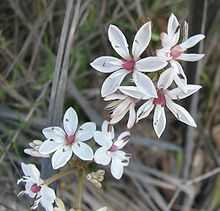Burchardia umbellata
| Burchardia umbellata | |
|---|---|
 | |
| At Anglesea Heath | |
| Scientific classification | |
| Kingdom: | Plantae |
| (unranked): | Angiosperms |
| (unranked): | Monocots |
| Order: | Liliales |
| Family: | Colchicaceae |
| Genus: | Burchardia |
| Species: | B. umbellata |
| Binomial name | |
| Burchardia umbellata R.Br.[1] | |
Burchardia umbellata (milkmaids) is a perennial herb native to woodlands and heath of southern Australia. It typically flowers in September, in dry sclerophyll forests.[2]
Size and shape
The narrow leaves of this plant are up to 60 cm long by 1.5 to 4 mm wide. Clusters of white or pale pink flowers with reddish centers sit atop a thin stalk that is 50 to 60 cm high.[3] Each flower measures about 2.5 cm wide.[3] There is a cluster of up to ten carrot-shaped tubers at the base, each about 5 mm thick.[4]
Use as food
Aborigines eat the potato-like tubers.[5] The tubers can be eaten raw or cooked. They are white, fleshy, crisp, and starchy, with a nondescript flavor.[2]
Origin of name
The genus Burchardia is named for German botanist Johann Heinrich Burckhardt. The species name umbellata is Latin for "umbrella", referring to the umbels of flowers.[3]
Cultivation
This plant is rarely available in nurseries, but it can be propagated by seed and kept in containers. It requires moist, well-drained soils and sun or light shade.[3]
References
- ↑ "Burchardia umbellata". Australian Plant Name Index (APNI), IBIS database. Centre for Plant Biodiversity Research, Australian Government.
- ↑ 2.0 2.1 Australian Botany Pages. Australian National Botanic Gardens
- ↑ 3.0 3.1 3.2 3.3 Burchardia umbellata. Australian Native Plants Society.
- ↑ Low, T. Wild Food Plants of Australia. 1988. ISBN 0-207-16930-6
- ↑ Gott, B. Aboriginal Trail. Australian National Botanic Gardens.
| Wikimedia Commons has media related to Burchardia umbellata. |